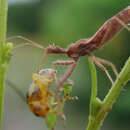en
names in breadcrumbs


Antennal olfactions and vision are key to the lifestyle of Sinea diadema. The ability to sense vibrations is also important, especially when it comes to enemy avoidance. However, studies have shown that vision is the most important sense for avoiding enemies.
Communication Channels: visual ; chemical
Other Communication Modes: vibrations
Perception Channels: visual ; vibrations ; chemical
This species is not believed to need any special conservation.
US Federal List: no special status
CITES: no special status
After hatching from the egg, Sinea diadema develops into a nymph, resembling the adult form, but without wings. The nymph molts five times, and will hibernate just before the last molt to emerge in the summer season as a reproductive adult.
Development - Life Cycle: metamorphosis
Although these bugs typically avoid humans, if roughly handled, Sinea diadema can bite. The bite may be painful, but not deadly.
Negative Impacts: injures humans (bites or stings)
These bugs attack many agricultural and horticultural pests, so are beneficial to human interests.
Positive Impacts: controls pest population
Because Sinea diadema feeds on many pest insects that destroy valuable crops, they are a desired species. They contribute to the natural balance of their habitat and control insect populations in the process.
Sinea diadema preys on organism such as aphids, caterpillar eggs, leafhoppers, lady bugs, and asparagus beetle eggs and larvae. The sharp beak mouthpart on the head is used to stab into the prey, allowing Sinea diadema to pierce through the prey's outer covering and then to suck out the body fluids.
Animal Foods: eggs; body fluids; insects
Primary Diet: carnivore (Eats eggs, Eats body fluids, Insectivore )
Sinea diadema is typically found in Southern North America, namely in the Southern United States and Northern Mexico.
Biogeographic Regions: nearctic
Sinea diadema is generally found in grasslands, gardens, and fields. They are found living among flowers and in crops.
Habitat Regions: temperate ; terrestrial
Terrestrial Biomes: savanna or grassland ; scrub forest
Other Habitat Features: agricultural
Sinea diadema has a long, narrow head that supports a short beak, formed by three segments. Also found on the head are slender antennae, each composed of four segments. The large size of the head is to support the beak that is so necessary for prey capture and consumption. Unlike other assassin bugs that are often bicolored, Sinea diadema is dark brown or a dull red. The eyes are reddish brown. The front legs are slightly swollen and covered with spines. The abdominal area is expanded, flat, and displays a pale spot on the rear margin of every segment. Because the middle of the abdomen is so wide, the wings cannot completely cover the entire body.
Range length: 12 to 16 mm.
Sexual Dimorphism: sexes alike
Other Physical Features: ectothermic ; bilateral symmetry
The dark brown and dark red coloring allows for cryptic coloration. Studies have shown that if Sinea diadema is in a state of starvation, it will resort to cannibalism, namely on the siblings that surround it.
Anti-predator Adaptations: cryptic
Although both vision and antennal olfaction are important to various life processes, no further information was available for specific mating systems of Sinea diadema.
The female Sinea diadema deposits large amounts of brown, cylindrical eggs in an upright position. These eggs are usually located on a leaf or within the soil, and are covered with a reddish brown secretion.
Breeding season: June though October
Average eggs per season: Many.
Key Reproductive Features: seasonal breeding ; sexual ; fertilization (Internal ); oviparous
After laying the eggs, the female and male have no further parental contact with the young.
Parental Investment: no parental involvement
Sinea diadema is a species of assassin bug family (Reduviidae), in the subfamily Harpactorinae. Sinea diadema is bivoltine, preys on small bugs and beetles, and overwinters in the egg stage.
In English the species goes by the common name spined assassin bug.[1] Its scientific name comes from Hebrew, where sinea means thorn bush or burning bush while diadema means crown.[2]
Cannibalism is not common in this species. However, when it occurs it usually involves a larger female eating a smaller male.[3]: 551
Females can lay up to 412 eggs in laboratory conditions.[4]: 514 Eggs are laid in clusters.[5]: 94
It is native to North America and found in the Midwest in fields, often associated with goldenrod Solidago missouriensis Nuttall.[6] They are typically found in grasslands, gardens, as well as fields.[7]
Sinea diadema is a species of assassin bug family (Reduviidae), in the subfamily Harpactorinae. Sinea diadema is bivoltine, preys on small bugs and beetles, and overwinters in the egg stage.